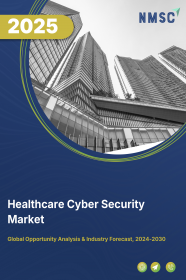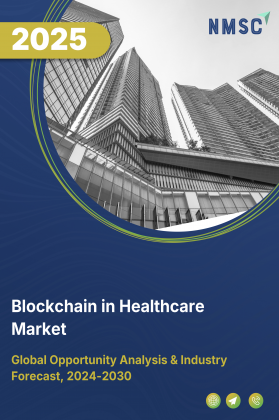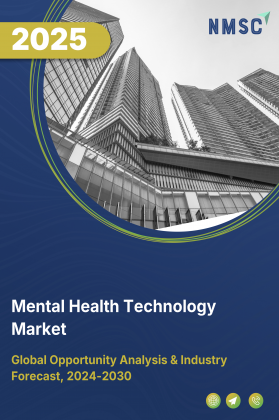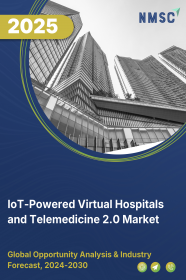
Healthcare Cybersecurity Market by Solution (Antivirus and Anti-Malware Protection, Risk and Compliance Management, Security Information and Event Management, Distributed Denial-Of-Service (DDoS) Mitigation, Identity and Access Management, and Other Solutions), by Security (Cloud Security, Network Security, Endpoint Security, and Other Securities), and by End-user – Global Opportunity Analysis and Industry Forecast, 2024–2030
Industry: Healthcare | Publish Date: 15-Feb-2025 | No of Pages: 261 | No. of Tables: 182 | No. of Figures: 139 | Format: PDF | Report Code : HC217
Market Overview
The Healthcare Cybersecurity Market size was valued at USD 18.2 billion in 2023, and is predicted to reach USD 62.1 billion by 2030, with a CAGR of 15.3% from 2024 to 2030.
Healthcare cybersecurity involves using various technologies and practices to protect digital health information and systems in the healthcare industry. It ensures that electronic health records, medical devices, and other important healthcare infrastructure remain safe from unauthorized access and cyber threats. The main goal is to keep healthcare services running smoothly, protect patient privacy, and prevent problems such as cyber-attacks and data breaches. This market uses advanced technologies and security measures to address evolving cyber threats faced by healthcare organizations worldwide. As healthcare becomes more digital, cybersecurity becomes increasingly important for keeping healthcare systems and data secure and reliable.
Rising Incidences of Cyberattacks Globally Increase the Demand for Healthcare Cybersecurity
The healthcare industry has emerged as a primary target for cybercriminals, confronting a surge in cyberattacks that has become a prevalent concern. According to the U.S. Department of Health & Human Services, in 2023, over 88 million people experienced significant breaches involving their personal health information, illustrating the heightened vulnerability of the sector to malicious activities.
Nearly 75% of ransomware attacks succeeded in encrypting data, marking the highest rate of encryption observed in the past three years. This alarming increase, up 2022’s 61%, underscores the evolving tactics and capabilities of cybercriminals in targeting healthcare entities. Notably, hospitals, clinics, and research labs find themselves at the forefront of cybersecurity challenges, grappling with complex and diverse range of challenges posed by cybersecurity risks.
Moreover, the IBM X-Force Threat Intelligence Index 2023, a report published by IBM’s in-house team of cybersecurity experts and remediators, sheds light on the global distribution of healthcare attacks, revealing that while X-Force has consistently responded to approximately 5% to 6% of healthcare cases over the past three years, the majority of healthcare attacks in 2022 occurred in Europe (58%), with North America following closely at 42%.
This geographic concentration emphasizes the need for tailored cybersecurity strategies across different regions. To counter these challenges, healthcare organizations are establishing rapid response mechanisms (regular monitoring, containment, eradication, and recovery from cyber threats), leveraging managed services, and integrating advanced technologies such as artificial intelligence (AI) and machine learning algorithms. These technologies, when combined with traditional cybersecurity frameworks, form a comprehensive defense against the evolving tactics of cyber adversaries.
Government Initiatives and Law Enforcements to Combat Cyberattacks Fuels Market Growth
Governments worldwide recognize the escalating cyber threats faced by healthcare institutions and acknowledge the importance to fortify the sector against potential breaches. As a result, they have taken proactive measures to champion cybersecurity in healthcare through strategic initiatives and financial support.
Moreover, governments are enacting legislations to define clear guidelines for protecting health information, establish data privacy standards, and delineate cybersecurity best practices within the healthcare sector. These legal frameworks serve as a roadmap for healthcare organizations and provide a basis for regulatory compliance, fostering a culture of cybersecurity vigilance.
The U.S., through the Department of Homeland Security (DHS), has taken a significant step forward by releasing a report titled "Harmonization of Cyber Incident Reporting to the Federal Government." This report serves as a working template for implementing cyber incident reporting regulations by the Cybersecurity and Infrastructure Security Agency (CISA). This proactive approach from the DHS contributes to a more standardized and coordinated response to cyber incidents, enhancing the overall cybersecurity resilience of healthcare institutions in the country.
Moreover, on the European front, the European Commission has made strides by adopting the first-ever European cybersecurity certification scheme, aligning with the EU Cybersecurity Act. This certification scheme provides a union-wide set of rules and procedures governing the certification of Information and communication technology (ICT) products throughout their lifecycle. The objective is to enhance the trustworthiness of these products for users. This initiative bolsters cybersecurity across various sectors and extends its impact to the healthcare cybersecurity market, ensuring that medical technologies and systems adhere to rigorous standards.
Insufficient and Lack of Skilled Cybersecurity Professionals to Hinder Market Expansion
The growth of the healthcare cybersecurity market encounters a formidable restraint due to insufficient skilled cybersecurity professionals, particularly in developing countries. There is a recognized scarcity of experts capable of addressing the intricate challenges posed by cybercrimes in healthcare. Developing nations, facing difficulties in recruiting and retaining these specialized professionals, find it challenging to establish robust security frameworks within healthcare systems.
The complex nature of healthcare cybersecurity, limited resources, and educational disparities hampers the swift adoption of advanced cybersecurity practices. This shortage impacts patient data protection and compromises incident response capabilities, leaving healthcare organizations vulnerable to prolonged cybersecurity threats.
Integration of Blockchain Technology to Combat Healthcare Cybercrimes Creates Market Opportunities
The integration of blockchain technology emerges as a pivotal factor in creating substantial opportunities for the Healthcare Cybersecurity Market in the future. With the escalating threats to digital service users' personal and financial information globally, particularly from sophisticated attacks including phishing, blockchain offers a promising solution to enhance cybersecurity. Blockchain's inherent characteristics, such as immutability and resistance to modification, provide a secure environment for storing sensitive patient information.
By placing patient data on a blockchain, individuals gain control and can share a single, unalterable version of their health records. This not only empowers patients but also fortifies the protection against cyberattacks. Furthermore, blockchain facilitates the development of decentralized security systems, distributing data across various network nodes.
This decentralized approach significantly raises the bar for hackers, demanding substantial time and resources to compromise multiple nodes, thereby elevating overall cybersecurity in the healthcare sector. Utilizing blockchain in healthcare exemplifies a proactive measure against cybercrimes, safeguarding applications, systems, and data through decentralization.
North America dominates the Healthcare Cybersecurity Market
The increasing frequency of cyberattacks in the healthcare sector of North America is fueling the expansion of the healthcare cybersecurity market in this region. The U.S. experiences the highest number of ransomware attacks worldwide, comprising 15% of all reported incidents. Additionally, in April 2022, 65 hospitals and 450 healthcare facilities in the U.S. fell victim to cyberattacks, resulting in compromised patient data and approximately USD 100 million in losses.
As ransomware attacks and other malicious activities continue to pose significant risks to patient data and healthcare infrastructure, there is a pressing need for proactive security solutions and strategies to defend against cyber threats and safeguard the integrity, confidentiality, and availability of critical healthcare systems and information in the region.
Moreover, government investment in healthcare cybersecurity is further playing a pivotal role in driving the growth of the market, particularly in countries such as Canada, the U.S., and Mexico. These governments are recognizing the critical importance of protecting healthcare systems and patient data from cyber threats. Canada government announced a substantial investment of USD 34.4 billion to modernize its healthcare infrastructure, with a focus on integrating advanced technologies.
This investment aims to enhance the efficiency and effectiveness of healthcare delivery while ensuring robust cybersecurity measures are in place to safeguard sensitive information. This strategic investment creates a significant opportunity for the healthcare cybersecurity market to expand in this region.
Asia-Pacific is expected to show steady growth in the Healthcare Cybersecurity Market
The surge in cyber-attacks targeting the healthcare sector, coupled with inadequate cybersecurity measures in countries such as India, Thailand, and the Philippines, is fueling the demand for healthcare cybersecurity solutions in this region, thus propelling market growth. India, for instance, lags behind in cybersecurity readiness, as evidenced by its cybersecurity score of 40% according to the National Cyber Security Index 2023.
To address this gap, the Indian government has ramped up efforts to enhance cybersecurity infrastructure, allocating significant funds for this purpose. In February 2023, the Ministry of Electronics and Information Technology (MeitY) received a substantial investment of USD 754 million, with a focus on bolstering cybersecurity initiatives.
A major portion of this funding, amounting to USD 482 million, is dedicated to Cyber Security projects, while USD 271 million is allocated to fortify the Indian Computer Emergency Response Team (CERT-In), the country's cybersecurity response unit. This substantial financial commitment underscores the government's determination to strengthen India's cybersecurity landscape and safeguard critical healthcare systems and data from cyber threats.
Moreover, the increasing frequency of cyberattacks in this region is driving further growth in the healthcare cybersecurity market. Recently, in October 2022, Osaka General Medical Center in Japan fell victim to a cyberattack, resulting in the loss of patient data and disruption to the organization's medical record system for approximately two months.
Additionally, Indonesia has encountered a significant surge in cyberattacks, with the country experiencing over 3,300 cyberattacks per week in 2022, marking the highest number of attacks in the Southeast Asian region. The increase in cyberattacks is fueling the demand for advanced cybersecurity solutions in the region, leading to the growth of the market.
Competitive Landscape
Several market players operating in the healthcare cybersecurity market include Palo Alto Networks Inc., Cisco Systems Ltd., Fortinet Inc., Crowdstrike, Check Point Software Technologies Ltd., Microsoft Corporation, Zscaler, IBM Corporation, Trend Micro, and Arista Networks, Inc. among others. These companies are adopting various strategies such as product launches to remain dominant in the healthcare cybersecurity market.
For instance, in January 2024, Fortinet launched the industry's first Wi-Fi 7-enabled secure networking solution, positioning itself as one of the first major enterprise vendors to introduce Wi-Fi 7. This secure networking solution improves healthcare cybersecurity by providing comprehensive protection for healthcare networks, data, and devices.
Moreover, in December 2023, Palo Alto Networks acquired Talon Cyber Security to extends its SASE (Secure Access Service Edge) solution for protecting all managed and unmanaged devices among various industries including healthcare. It provides an additional layer of protection against phishing attacks, web-based attacks, and malicious browser extensions.
Key Market Segments
By Solution
-
Antivirus and Anti Malware Protection
-
Risk and Compliance Management
-
Security Information and Event Management
-
Distributed Denial-of-Service (DDoS) Mitigation
-
Identiity and Access Management
-
Other Solutions
By Security
-
Cloud Security
-
Network Security
-
Endpoint Security
-
Other Securities
By End User
-
Hospitals & Clinics
-
Pharmaceutical & Biotechnology Industries
-
Health Insurance Companies
-
Medical Device Companies
By Region
-
North America
-
U.S
-
Canada
-
Mexico
-
-
Europe
-
UK
-
Germany
-
France
-
Italy
-
Spain
-
Denmark
-
Netherlands
-
Finland
-
Sweden
-
Norway
-
Russia
-
Rest of Europe
-
-
Asia-Pacific
-
China
-
Japan
-
India
-
South Korea
-
Australia
-
Indonesia
-
Singapore
-
Taiwan
-
Thailand
-
Rest of Asia-Pacific
-
-
RoW
-
Latin America
-
Middle East
-
Africa
-
Key Players
-
Palo Alto Networks Inc.
-
Cisco Systems Ltd.
-
Fortinet Inc.
-
Crowdstrike
-
Check Point Software Technologies Ltd.
-
Microsoft Corporation
-
Zscaler
-
IBM Corporation
-
Trend Micro
-
Arista Networks, Inc.
REPORT SCOPE AND SEGMENTATION:
|
Parameters |
Details |
|
Market Size in 2023 |
USD 18.2 Billion |
|
Revenue Forecast in 2030 |
USD 62.1 Billion |
|
Growth Rate |
CAGR of 15.3% from 2024 to 2030 |
|
Analysis Period |
2023–2030 |
|
Base Year Considered |
2023 |
|
Forecast Period |
2024–2030 |
|
Market Size Estimation |
Billion (USD) |
|
Growth Factors |
|
|
Countries Covered |
28 |
|
Companies Profiled |
10 |
|
Market Share |
Available for 10 companies |
|
Customization Scope |
Free customization (equivalent up to 80 working hours of analysts) after purchase. Addition or alteration to country, regional, and segment scope. |
|
Pricing and Purchase Options |
Avail customized purchase options to meet your exact research needs. |




















 Speak to Our Analyst
Speak to Our Analyst

























